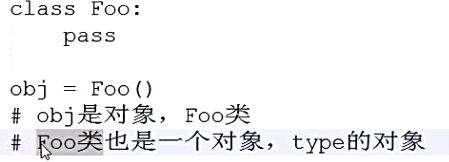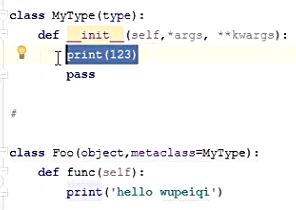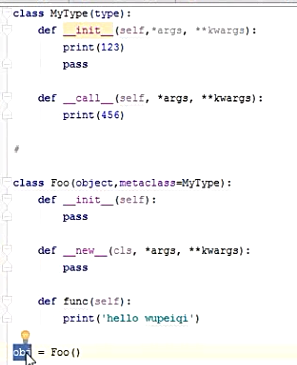1、成员修饰符 2、特殊成员 3、metaclass,类的祖宗
###成员修饰符###
公有和私有

1 #__author:_nbloser 2 #date:2018/1/19 3 4 #私有类、对象成员变量,方法;在前面加两个下划线'__' 5 class Person: 6 __lover = '***' # 私有类字段,外部不能够直接访问 7 8 @staticmethod 9 def retu_lover(): 10 return Person.__lover 11 12 def __init__(self,name,age): 13 self.name = name 14 self.__age = age # 私有对象字段,外部不能够直接访问 15 16 @property 17 def show_age(self): 18 return self.__age 19 20 obj = Person('x',21) 21 print(obj.name) 22 print(obj.show_age) # 通过python属性获取
****子类也不能直接访问父类的私有字段
### 特殊成员###
#__call__方法
class Person: def __init__(self): print('init') def __call__(self,*args,**kwargs): print('call') obj = Person() obj() # 这个对应的是执行__call__方法,一般也不用
#__add__方法
class Person: def __add__(self,other): return 123 # self=obj,other=obj2,可以让这个两个对象的字段相加,或者其他操作 obj = Person() obj2 = Person() x = obj + obj2 # 两个对象相加时,自动执行第一个对象的__add__方法,并且将第二个对象当作参数传递进入 print(x,type(x)) # 123<class'int'>
#__dict__(重点)
class Person: def __init__(self, name,age): self.name = name self.age = age obj = Person('x',21) print(obj.__dict__) # {'name':'x','age':21} # 通过字典把成员显示出来
## __getitem__、__setitem__、__delitem__方法、切片
只有__getitem__有返回值
class Person: def __init__(self,name,age): self.name = name self.age = age def __getitem__(self,item): return item + 10 def __setitem__(self,key,value): print(key,value) def __delitem__(self,key): print(key) k = Person('x',21) c = k[8] # 对应执行__getitem__方法 print(c) k[8] = 235 # 8 235 # 对应执行__setitem__方法 del k[8] # 8 # 对应执行__delitem__方法
加上切片处理的,以__getitem__方法为例
def __getitem__(self,item): # 如果item是基本类型:int,str,索引获取。如果是slice对象的话,切片 if type(item) == slice: print(item.start) print(item.stop) print(item.step) print('切片处理') else: print('索引处理') c = k[8] # 索引处理 c = k[8:10:2] # 切片处理
##实现对象可以迭代
class Person: def __init__(self,name,age): self.name = name self.age = age def __iter__(self): return iter([11,22,33]) l = Person('x',21) for i in l: print(i)
这里只是介绍。
###metaclass,类的祖宗###
def function(self): print(213) Foo = type('foo',(object,),{'func':function}) r = Foo() r.func()
这样也是声明了一个类

这个我不知道为什么实现不了,所以我直接截图了。而且很懵,不知道用得多不多,暂时没有找别的博客,好像在Java里面好像没有看到使用太多这些。
先执行type的方法,才执行类的方法

obj真正是在__new__里面创建的
盗过来的创建对象流程图,作者:武沛齐

一些有关的代码:(有的话会继续编辑补上)
1、example_043 in java_300

1 public class Book 2 { 3 private String title; 4 private String author; 5 private double price; 6 public Book(String title, String author, double price) { 7 super(); 8 this.title = title; 9 this.author = author; 10 this.price = price; 11 } 12 public String getTitle() 13 { 14 return title; 15 } 16 public String getAuthor() 17 { 18 return author; 19 } 20 public double getPrice() 21 { 22 return price; 23 } 24 25 }

1 public class Test 2 { 3 public static void main(String[] args) 4 { 5 // TODO 自动生成的方法存根 6 Book book = new Book("x", "_nblsoer", 99999.99); 7 System.out.println("书名:"+book.getTitle()); 8 System.out.println("作者:"+book.getAuthor()); 9 System.out.println("价格:"+book.getPrice()); 10 } 11 }

1 # __author: _nbloser 2 # date: 2018/1/22 3 4 class Book: 5 def __init__(self, book_name, author, price): 6 self.__book_name = book_name 7 self.__author = author 8 self.__price = price 9 10 @property 11 def book_name(self): 12 return self.__book_name 13 14 @book_name.setter 15 def book_name(self, val): 16 self.__book_name = val 17 18 @property 19 def author(self): 20 return self.__author 21 22 @author.setter 23 def author(self, val): 24 self.__author = val 25 26 @property 27 def price(self): 28 return self.__price 29 30 @price.setter 31 def price(self, val): 32 self.__price = val

1 # __author: _nbloser 2 # date: 2018/1/22 3 4 import book 5 book = book.Book('xxxx','_nbloser',964) 6 print(book.book_name,book.author,book.price) 7 book.book_name = 'change' 8 book.author = 'a loser' 9 book.price = 99999999.99 10 print(book.book_name,book.author,book.price)
2、
